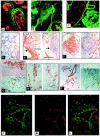Human trophoblast invasion and spiral artery transformation: the role of PECAM-1 in normal pregnancy, preeclampsia, and fetal growth restriction
- PMID: 11337369
- PMCID: PMC1891950
- DOI: 10.1016/S0002-9440(10)64127-2
Human trophoblast invasion and spiral artery transformation: the role of PECAM-1 in normal pregnancy, preeclampsia, and fetal growth restriction
Abstract
During early human pregnancy extravillous cytotrophoblasts invade the uterus and spiral arteries transforming them into large vessels of low resistance. Failure of trophoblast invasion and spiral artery transformation occurs in preeclampsia and fetal growth restriction (FGR); these processes are not well understood. Recent studies have suggested that cytotrophoblasts that invade spiral arteries mimic the endothelial cells they replace and express PECAM-1. It was also reported that in preeclampsia, cytotrophoblasts fail to express PECAM-1 and that failure to express endothelial cell adhesion molecules may account for failed trophoblast invasion. Despite the possible importance of adhesion molecules in trophoblast invasion, no study has systematically investigated the expression of PECAM-1 in the placental bed throughout the period of invasion, particularly in the myometrial segments where the key failure occurs. There are no studies on PECAM-1 expression in the placental bed in FGR. We have examined the expression of PECAM-1 in placental bed biopsies and placentas from 8 to 19 weeks of gestation and in the placenta and placental bed in the third trimester in cases of preeclampsia, FGR, and control pregnancies. PECAM-1 was expressed on endothelium of vessels in the placenta and placental bed but not by villous or extravillous trophoblasts in normal or pathological samples. These findings do not support a role for PECAM-1 in normal invasion or in the pathophysiology of preeclampsia or FGR.
Figures



Similar articles
-
Failure of physiologic transformation of spiral arteries, endothelial and trophoblast cell activation, and acute atherosis in the basal plate of the placenta.Am J Obstet Gynecol. 2017 Mar;216(3):287.e1-287.e16. doi: 10.1016/j.ajog.2016.12.029. Epub 2016 Dec 27. Am J Obstet Gynecol. 2017. PMID: 28034657 Free PMC article.
-
Spiral artery remodeling and trophoblast invasion in preeclampsia and fetal growth restriction: relationship to clinical outcome.Hypertension. 2013 Dec;62(6):1046-54. doi: 10.1161/HYPERTENSIONAHA.113.01892. Epub 2013 Sep 23. Hypertension. 2013. PMID: 24060885
-
Transforming growth factor-beta expression in human placenta and placental bed in third trimester normal pregnancy, preeclampsia, and fetal growth restriction.Am J Pathol. 2001 Nov;159(5):1827-38. doi: 10.1016/s0002-9440(10)63029-5. Am J Pathol. 2001. PMID: 11696443 Free PMC article.
-
Why is placentation abnormal in preeclampsia?Am J Obstet Gynecol. 2015 Oct;213(4 Suppl):S115-22. doi: 10.1016/j.ajog.2015.08.042. Am J Obstet Gynecol. 2015. PMID: 26428489 Free PMC article. Review.
-
TGFβ signalling: a nexus between inflammation, placental health and preeclampsia throughout pregnancy.Hum Reprod Update. 2024 Jul 1;30(4):442-471. doi: 10.1093/humupd/dmae007. Hum Reprod Update. 2024. PMID: 38519450 Free PMC article. Review.
Cited by
-
Interferon-α and angiogenic dysregulation in pregnant lupus patients who develop preeclampsia.Arthritis Rheumatol. 2015 Apr;67(4):977-87. doi: 10.1002/art.39029. Arthritis Rheumatol. 2015. PMID: 25603823 Free PMC article.
-
The complement system at the embryo implantation site: friend or foe?Front Immunol. 2012 Mar 19;3:55. doi: 10.3389/fimmu.2012.00055. eCollection 2012. Front Immunol. 2012. PMID: 22566936 Free PMC article.
-
The microstructure in the placenta is influenced by the functional diversity of HLA-G allelic variants.Immunogenetics. 2019 Jul;71(7):455-463. doi: 10.1007/s00251-019-01121-0. Epub 2019 Jun 27. Immunogenetics. 2019. PMID: 31250049 Free PMC article.
-
Macrophage migration inhibitory factor in fetoplacental tissues from preeclamptic pregnancies with or without fetal growth restriction.Clin Dev Immunol. 2012;2012:639342. doi: 10.1155/2012/639342. Epub 2011 Oct 4. Clin Dev Immunol. 2012. PMID: 22007254 Free PMC article.
-
The Role of LIN28-let-7-ARID3B Pathway in Placental Development.Int J Mol Sci. 2020 May 21;21(10):3637. doi: 10.3390/ijms21103637. Int J Mol Sci. 2020. PMID: 32455665 Free PMC article. Review.
References
-
- Pijnenborg R, Bland JM, Robertson WB, Brosens I: Uteroplacental arterial changes related to interstitial trophoblast migration in early human pregnancy. Placenta 1983, 4:397-414 - PubMed
-
- Brosens I, Robertson WB, Dixon HG: The physiological response of the vessels of the placental bed to normal pregnancy. J Pathol Bacteriol 1967, 93:569-579 - PubMed
-
- Pijnenborg R, Dixon G, Robertson WB, Brosens I: Trophoblastic invasion of human decidua from 8 to 18 weeks of pregnancy. Placenta 1980, 1:3-19 - PubMed
-
- Sheppard BL, Bonnar J: The ultrastructure of the arterial supply of the human placenta in pregnancy complicated by fetal growth retardation. J Obstet Gynaecol Br Cwlth 1976, 83:948-959 - PubMed
-
- De Wolf F, De Wolf-Peeters C, Brosens I: Ultrastructure of the spiral arteries in human placental bed at the end of normal pregnancy. Am J Obstet Gynecol 1973, 117:833-848 - PubMed
Publication types
MeSH terms
Substances
LinkOut - more resources
Full Text Sources
Miscellaneous

